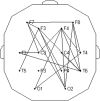Detection of respiratory frequency rhythm in human alpha phase shifts: topographic distributions in wake and drowsy states
- PMID: 39835197
- PMCID: PMC11743705
- DOI: 10.3389/fphys.2024.1511998
Detection of respiratory frequency rhythm in human alpha phase shifts: topographic distributions in wake and drowsy states
Abstract
Introduction: The relationship between brain activity and respiration is recently attracting increasing attention, despite being studied for a long time. Respiratory modulation was evidenced in both single-cell activity and field potentials. Among EEG and intracranial measurements, the effect of respiration was prevailingly studied on amplitude/power in all frequency bands.
Methods: Since phases of EEG oscillations received less attention, we applied our previously published carrier frequency (CF) mathematical model of human alpha oscillations on a group of 10 young healthy participants in wake and drowsy states, using a 14-channel average reference montage. Since our approach allows for a more precise calculation of CF phase shifts (CFPS) than any individual Fourier component, by using a 2-s moving Fourier window, we validated the new method and studied, for the first time, temporal waveforms CFPS(t) and their oscillatory content through FFT (CFPS(t)).
Results: Although not appearing equally in all channel pairs and every subject, a clear peak in the respiratory frequency region, 0.21-0.26 Hz, was observed (max at 0.22 Hz). When five channel pairs with the most prominent group averaged amplitudes at 0.22 Hz were plotted in both states, topographic distributions changed significantly-from longitudinal, connecting frontal and posterior channels in the wake state to topographically split two separate regions-frontal and posterior in the drowsy state. In addition, in the drowsy state, 0.22-Hz amplitudes decreased for all pairs, while statistically significant reduction was obtained for 20/91 (22%) pairs.
Discussion: These results potentially evidence, for the first time, the respiratory frequency modulation of alpha phase shifts, as well as the significant impact of wakeful consciousness on the observed oscillations.
Keywords: alpha activity; electroencephalography; mind–body interaction; phase shift; respiration; wake and drowsy.
Copyright © 2025 Kalauzi, Matić, Suljovrujić and Bojić.
Conflict of interest statement
The author(s) declared that they were an editorial board member of Frontiers, at the time of submission. This had no impact on the peer review process and the final decision.
Figures













References
LinkOut - more resources
Full Text Sources

